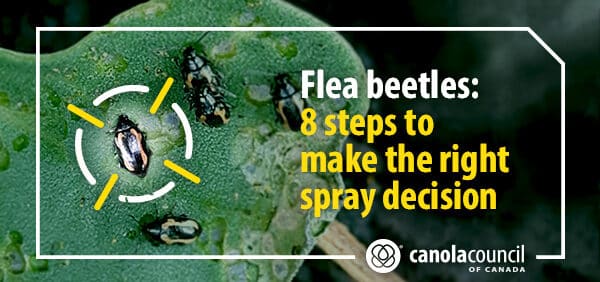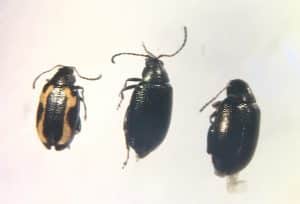Seed treatment usually provides effective protection through the risk period for flea beetles, but slow-growing crops under intense flea beetle pressure may require foliar insecticide. Here are 8 steps to make the spray decision. (The following steps are also covered in the Canola Encyclopedia chapter on flea beetles.)
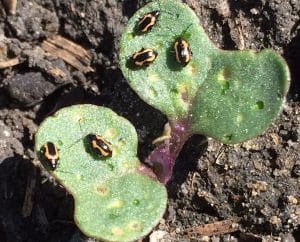
8 steps to make the right spray decision
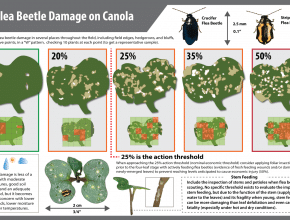
Step 1. Know the spray threshold. The action threshold for flea beetles in canola crops in Canada is an average leaf area loss of 25 per cent or more. Research to re-evaluate these thresholds found that canola with up to 25 per cent leaf area loss will yield the same as canola with no leaf area loss at all. Yield loss starts to show after 25 per cent leaf area loss, reaching levels anticipated to cause economic injury at 50 per cent. Researchers set an ‘action threshold’ because leaf area loss, in a heavy infestation, can escalate quickly from 25 to 50 per cent and beyond. Read the research behind this recommendation.
Exception: Thresholds are guidelines to help farmers make input decisions that provide a return on investment. If canola plants are slow growing and lack vigour while flea beetles are numerous and aggressive, the action threshold could be met and surpassed very quickly. In that situation, growers may need to start spraying before 25 per cent. Continue through the following checklist to be sure. Canola Digest article with more on this.
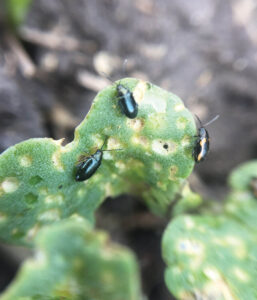
Step 2. Assess leaf area loss. With thresholds in mind, check plants in a number of areas of the field to get an average damage level. Scout the newest leaves. Flea beetles tend to prefer fresh new leaves. If cotyledons are chewed up but newest leaves show very little feeding, then plants may be outgrowing the threat or seed treatments may be having an effect (or both). On the other hand, if cotyledons are under 50% but first true leaves are not present, flea beetles may be nipping off fresh apical meristem – the growing point for first leaves. If the meristem is lost, these leaves could be considered 100% lost. Mark those plants (could use the ‘washer’ test) and return in a day or two to see if true leaves are showing. (More assessment details.)
Step 3. Assess stem damage. This is especially important in foul weather (wind, cool) that drives flea beetles down to leaf undersides and stems. While feeding marks on the stem are likely much more consequential than feeding on a leaf, we don’t currently have a way to include stem feeding in the leaf-area loss thresholds. One shallow feeding mark (could be a few flea-beetle-sized bites) might not do any damage at all, but feeding that eats through the fragile new stem or causes it to break could be fatal. Plants that die due to stem feeding would have 100% leaf area loss – but seedlings that die in this fashion are hard to find and could also be lost for various other reasons, including cutworms, frost and seedling diseases. They are often missed when it comes to damage assessment. The key: Look for stem damage when scouting. If leaf area loss is below thresholds, but flea beetles are present in high numbers and the crop is not advancing, stem feeding may be the reason. Growers and agronomists observing this situation may want to be more aggressive with their spray decision, especially if the stand is thin. They can’t afford to lose more plants.
Scouting note: Daily scouting needs to happen in areas approaching action threshold. Within two or three days, flea beetle feeding can escalate way beyond threshold, and actually wipe out whole areas of a field, especially in hot, dry and windy conditions.
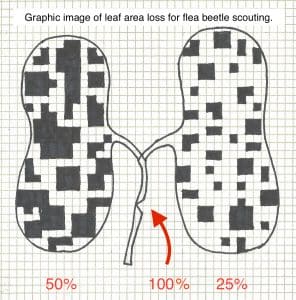
Step 4. Assess flea beetle feeding activity. Are the insects still present in the field and continuing to feed? If it looks like populations are dwindling, a spray may not be necessary. If flea beetles are slow and dopey, it may mean they have ingested seed treatment insecticide and are no longer feeding. Check again to make sure. Time of day and weather can influence flea beetle activity. On rainy days, for example, flea beetles will usually take cover, so rain will slow or even stop feeding for the time being. Rain can also help the crop more quickly recover.
Step 5. Consider the plant stand. This should influence your approach to the thresholds. With a thin stand of 4 plants per square foot, for example, growers can’t afford to lose any plants and may want to take action when damage is only 20-25%. But with counts in the high end of the recommend range (of 5 to 8 plants per square foot), growers can afford to lose a couple of plants without sacrificing harvest yield. (See management tips below, which include seed-time decisions to improve the stand.)
Step 6. Check the crop stage. After the 4-leaf stage (4 true leaves), the threat is likely over because the crop usually has enough plant material to feed flea beetles without compromising growth, and the plants can compensate for feeding better by this stage. If the crop is uneven (some plants are at the 4-leaf stage and some are earlier), keep scouting until most of the crop has at least 3 or 4 true leaves. Exception: If growing conditions (dry, for example) cause slow crop growth at the 4-leaf stage, continue to monitor these crops. In 2021, some canola crops at the 4-leaf stage had to be sprayed.
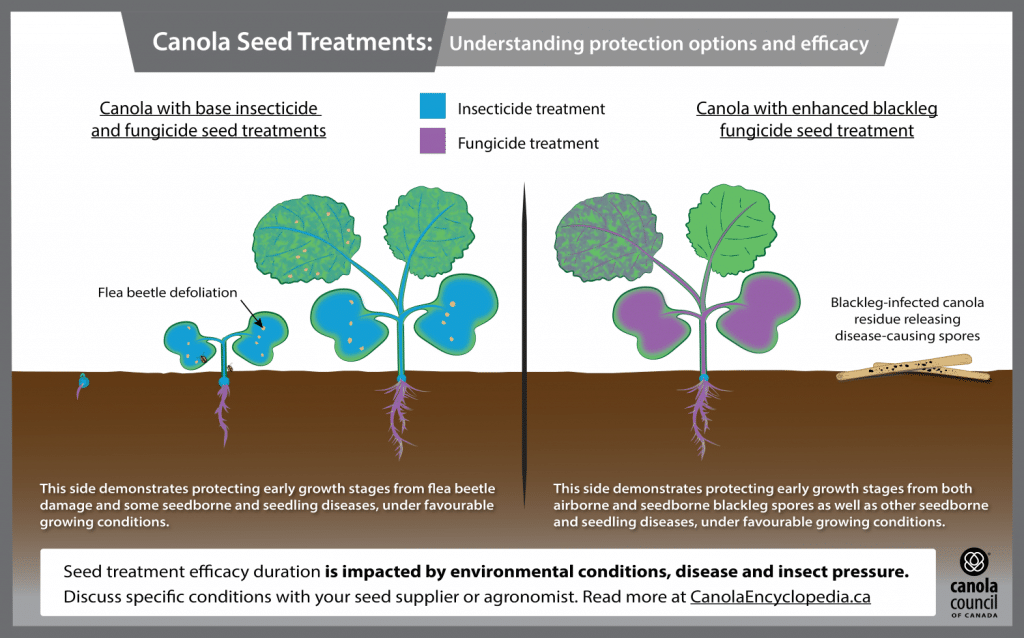
Step 7. Check canola fields frequently. Seed treatment insecticide starts working when the seed imbibes water and it can remain active for about 3-4 weeks after that point. If you have enough moisture for seed to imbibe and germinate, you have enough to solubilize the active ingredient and allow it to move into the plant. Flea beetles need to consume some plant tissue to get a dose of the protectant. High levels of flea beetles can overwhelm seed treatments. And in a slow developing crop, seed treatments can lose their protective capacities before the crop reaches the 4-leaf stage. Scout often during these first three weeks, and if flea beetle levels are building and are close to thresholds, daily checking for a few days may be required.
Step 8. If spraying is required, only use pesticides registered for flea beetles in canola. Refer to product labels for proper use instructions. No pre-harvest interval concerns exist for products applied at this growth stage, but this could be a deciding factor on which product to use later in the season – specific products are limited to one application per season and a grower may want to keep these in reserve. To improve results, also consider spray-time temperatures and nozzle type. Temperature: Pyrethroids have restrictions for application in higher temperatures. These are the most commonly used insecticides for flea beetles. The label for pyrethroid Decis (active ingredient deltamethrin), for example, says: “DO NOT spray under a strong temperature inversion, or when temperature exceeds 25°C as this will result in a reduction in control.” Nozzle: Tank mixing with herbicide also reduces efficacy because low-drift herbicide nozzles, which are a good practice for some herbicides, produce a coarse spray droplet that may not provide efficient coverage or flea beetle contact for higher product efficacy. As sprayer specialist Tom Wolf says, “the likelihood of a flea beetle ingesting leaf tissue at the spot where the insecticide hit is low, and gets lower the larger the droplets.”
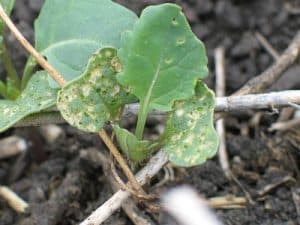
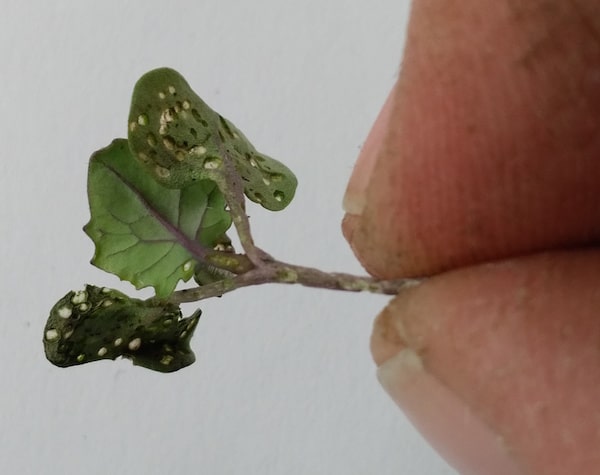
More…
- Flea beetles: Management tips (for better foliar spray results and faster crop establishment)
- Canola Encyclopedia section on flea beetles
- Canola Encyclopedia section on seed treatments
- Insecticide tips: “On the seed or on the beetle?” webinar
- Canola Digest article on flea beetle challenges and management update
- Late-season flea beetles
- Flea beetle findings that shape management choices (Canola Research Hub blog)

